In today’s competitive digital world, personalization has become essential to provide better customer experiences, improve brand loyalty and customer retention.
What is personalization?
[A] defines personalization as the act of offering customers tailored experiences based on information a company has learned about an individual to increase engagement.
Personalization is data-driven. With the right tools it can be applied in digital or physical environments, such as:
- Websites
- Mobile apps
- Emails
- Online ads
- Online chats
- Call centers
- In-store/in-branch assistance
What kind of data can be acted on to tailor experiences in those channels? It’s basically an unlimited list that contains any information a company can collect about its customers and prospects. Some of the most common include:

Demographic data – A collection of all the data points about a person, such as their name, email, title, gender, and location.
 Behavioral data
Behavioral data – Reveals everything about a visitor’s actions while using your website or app, such as pages visited, links clicked, average time on site, and number of visits, acquisition channel (such as search, email, social, paid ad, referring site) time elapsed since last visit, emails open, or call center interaction.

Contextual data – Related to a visitor’s unique properties while providing context to their behavior on a website or an app, such as device type, browser type, location, and time of the day.
Why personalization matters
Organizations are adopting personalized customer experiences to meet numerous business goals. It can increase engagement, drive conversions, foster loyalty, and improve a number of other KPIs. But at the broadest level, personalization is important because people have come to expect it.
Customers expect it
Consumers have become accustomed to being offered personalized content which has elevated consumer expectations for relevant, contextual, and convenient experiences to unprecedented heights. Many brands have been applying personalization, resulting in improved customer loyalty.
Spotify and Netflix are examples of personalized content. Spotify users rely on personalized playlists that are curates for them based on what they’ve listened to before. And the same applies for watching TV shows and movies through Netflix.
As more big brands have implemented forms of personalization, customers have come to expect various forms of personalization. Companies that are not implementing personalization strategies find that staying abreast with competition is becoming even more challenging.
Personalization is good for your business
Personalization matters more than ever, with the shift toward remote and work-from-home, expectations for digital experiences have increased. According to
McKinsey & Company, seventy-one percent of consumers expect companies to deliver personalized interactions. And seventy-six percent get frustrated when this doesn’t happen.
The importance of personalization for your business is actually quite straightforward. Personalization leads to:
- Higher per order value
- Higher engagement level (Click-through rates and Open rates)
- Higher brand loyalty
- Higher Customer Lifetime Value (LTV)
- Higher Marketing ROI
To put the significance of personalized Customer Experience for your business in numbers:
-
McKinsey & Company: “Companies that excel at personalization generate 40% more revenue from those activities than average players”
-
Hubspot: “Personalized Call-to-Actions convert 202% better than default versions.”
-
123 Form Builder: "90% of customers are willing to spend more when companies provide personalized customer services."
-
Accenture Research: “91% of consumers are more likely to shop with brands that recognize, remember, and provide them with relevant offers and recommendations.”
-
In 2022, "61% of customers would leave for a competitor after just one negative experience" up from the "48% of all consumers" in 2018 (123 Form Builder & Accenture Research).
Examples of personalization
1. Gender-based personalization
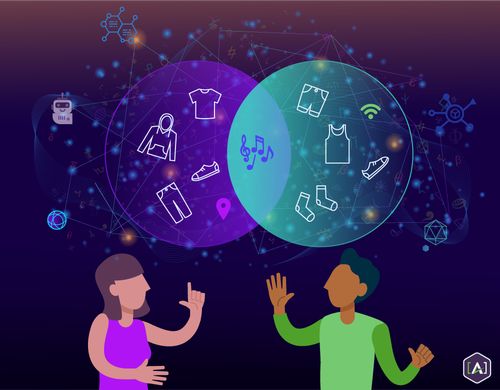
Pretty much any gender-specific product like clothing, shoes, jewelry, perfumes and many other products, can easily be converted into a personalized customer experience. It makes sense to improve the user experience based on gender, and instead of having the user search for male or female product offerings in your catalog or menu, be proactive as a company and offer a customized user experience and interface based on gender.
It should be noted that many corporations are becoming more responsive to the needs of non-binary people. For example, traditional fill-forms often required choosing a male or female social address (e.g. “Mr.” or “Ms.”). Forbes shares some instructive insights into how this creates distance with non-binary customers in their article “
More Than A Matter Of Pride: Addressing How Transgender And Non-Binary Banking Customers Are Treated.” Other trends are influencing actual products like apparel. There have been attempts to label clothing by type rather than gender. A
blog by Mercedes Viera shares insights into some of the pitfalls that may occur in this type or endeavor. For organizations that are aspiring to reach the broadest audience without friction on customer journeys, we recommend monitoring this trend on a regular basis.
2. Geolocation based personalization
A common personalization for international brands is to change the content and language of the content based on the location (country) the customer is in.
So US and Canadians might see English content with location specific offers on the example.com domain, while visitors from Latin America are redirected to an example.com.mx domain and see other types of content and product offers in Spanish.
However, many companies go a step further and allow users to customize their choice and remember that choice. This way an US expat in Mexico can choose to revert the language to English and indicate that his preference is the .com domain.
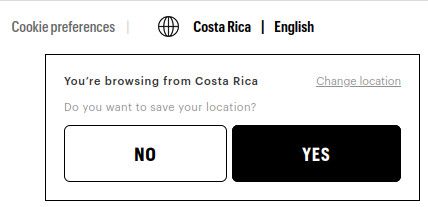
Offering geolocation based content yet allowing customization of language and content preferences are excellent personalization features that every international brand should have.
This feature has become so standardized that many companies have started to adopt the same icon to indicate location based preferences.
3. Product recommendation engines
One of the most prevalent personalization features is offering personalized product recommendations. Product personalization is based on product search and purchase histories or preferences indicated by the user.
If you went over to Amazon and searched for a ‘Dell laptop’, you would see something like this beneath the product you clicked.
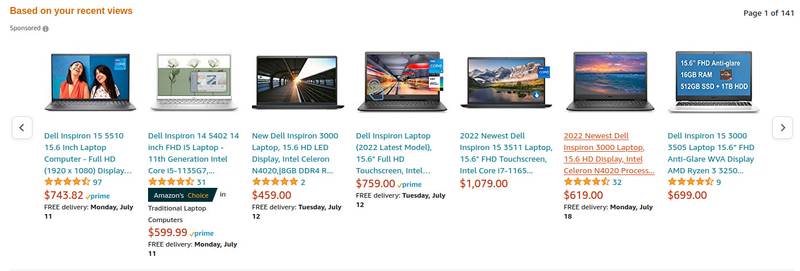
Basically, Amazon is saying:
- If you viewed this Dell laptop, you might also like these similar products.
- Also, customers that viewed that Dell laptop also checked out these other products. You might like them as well.
This is product recommendations in action.
You can make recommendations to customers based on:
- Best selling products
- Frequently bought together (complementary products)
- Trending products
- Featured products
- Most viewed products
- Most user reviews
- Highest users review score
- Personal search history
- Personal buying history
If you haven’t taken product recommendations seriously yet, you are leaving a lot of money on the table. Generally speaking, customer satisfaction increases with better product recommendations, which leads to higher conversion rates and reduces cart abandonment. Consumer satisfaction is crucial because most consumers are eager to spend more money with companies that deliver positive customer experiences. Currently, the global
customer service satisfaction rate is 77%.
It is also fairly easy to create recommendations on ecommerce sites as numerous 3rd party apps (aka product recommendation engines) exist that can be integrated on your website. Most product recommendations engines also use Artificial Intelligence (AI) to anticipate customer needs and thus improve per order value.
4. User Experience control & customization
Other forms of personalization are based on giving the user active control over some components of the user experience:
- Customizing screen colors/themes (slack,
- Creating Playlists (YouTube, Spotify, Netflix)
- Saving Favorites (content assets)
Allowing high levels of customization of the Interface and user experience ties the customer more closely into the product or brand.
5. Combine online and in-store personalization
Sephora, an international beauty-products retailer, has been widely acclaimed for its loyalty membership and personalization strategies. Sephora doesn’t approach online and offline experiences as separate, but as part of one member experience.
The company’s digital channels, particularly its mobile app, encourage customers to book in-store makeovers and fashion consultations. The app’s “in-store companion” feature enables users to find a store, check to see if an item is in stock, and book a reservation.
The app also allows customers to virtually try on products and to receive recommendations based on their personal beauty traits. When customers visit a Sephora store, they can use the app to find the products they have virtually sampled.
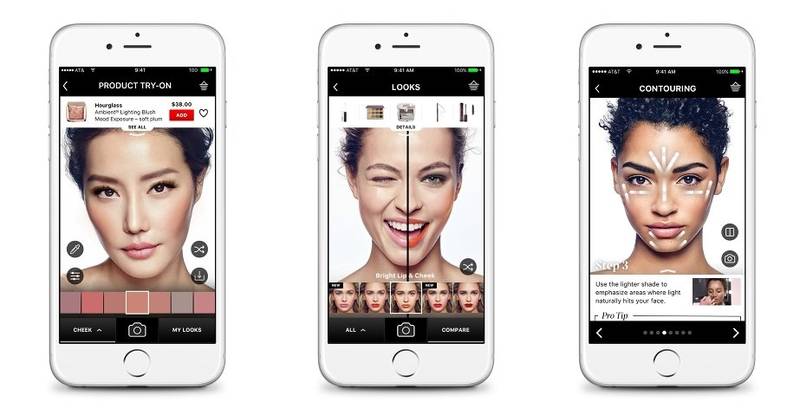
Sales associates can see customer’s loyalty points, and can access a customer’s profile in store. The profile includes data on the customer’s in-store purchases, online browsing and purchasing patterns, and interactions with in-store salespeople.
Their marketing strategy of a highly personalized omnichannel service in combination with a strong loyalty program has proven very successful:
- The loyalty program now has around 25 million members.
- In 2018, members accounted for 80 percent of Sephora’s total transactions. (Forbes, Jan 23, 2020)
6. Personalized Ads
An example of personalized cross-platform advertising is performing a search on google about hotels in Cancun, Mexico, then going to an unrelated website that has google display ads where you are offered ads from hotels in Cancun. This seems fairly easy as the ads are from the same source (Google). But then later you check new posts on your facebook newsfeed to find numerous ads from hotels in Cancun, some offering special time-limited discounts.
This is a prime example of how personalized cross-platform advertising is used on a daily basis.
While this might seem invasive to some, and controversy exists regarding privacy, it feels far more useful to receive ads about products and services that you're actually interested in rather than ads about irrelevant products and services that have no relevance for you.
7. Personalized Lead generation
Personalize the lead generation process by asking users what they need.
Example:
Marketing Automation Insider
Users provide information about their software needs, which refines the options the website provides as recommendations. The more information users submit, the more relevant the recommendations will be and Marketing Automation Insider allows users to get a free report sent to them by email.
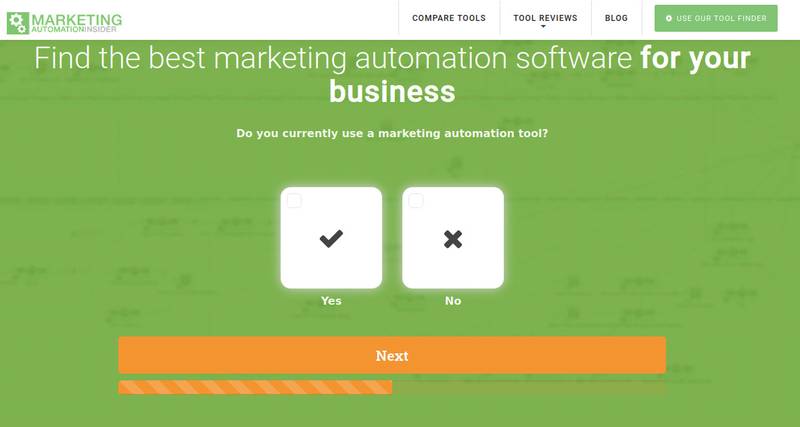
Applying this interactive approach takes a lot of guesswork out of the equation and allows for more efficient product recommendations and shortens the customer journey.
8. Personalized Search functions
Personalized search uses algorithms to combine user input in the search bar with other data points such as user preferences, browser history, and purchase history to surface the most relevant items for each person based on brands, categories, price ranges, etc.
Search results that consider each person’s preferences and intent will show products that are relevant to the individual, not just to the search term.
The key to personalized search is gathering information about the user’s preferences and taking it into account when providing results.
9. Personalized loyalty, reward & discount programs
Today’s customers not only expect to be rewarded instantly for shopping for their favorite brands, they also expect to be able to use their rewards immediately at the Point-of-Sale (POS).
But a customer loyalty program cannot be one size fits all. Different generations expect different types of rewards, and to receive those rewards through a variety of channels.
The wildly successful Starbucks app is a prime example of a personalized loyalty program. Starbucks remembers customers’ favorite drinks and preferences and rewards them with perks and freebies based on their preferences and past activity. Starbucks uses an AI algorithm to send more than 400,000 variants of personalized messages to customers to promote unique offers.
Starbucks sends rewards to customers instantly after a purchase through their app and allows those rewards points to be redeemed at the POS as well as being used for “to-go” orders.
10. Performance achievements
Prove the worth of your service/app/software by sending reports to users, showing them what they’ve achieved or can achieve with the tool.
This is a crucial strategy for any software platform that promises to boost productivity, business performance, or any other performance/achievement-oriented metrics, as it demonstrates how valuable the software is.
Besides demonstrating the value of the tool, this offers a convenient way to personalize the experience, by demonstrating through reporting how the user has improved or areas for improvement specific to the user.
Grammarly makes use of all the data it collects from its users to deliver weekly reports, providing an analysis of their writing technique.
Personalization trends
Personalization has become mainstream and many trends are shaping how companies adjust to gain customers. As the competitive landscape evolves, one of the most important goals for any company is staying ahead of these trends and anticipating each customer segments' needs.
Data Privacy and Cookieless Personalization
Consumers appreciate the convenience of personalization so long as their data is secure.
The digital world is evolving with the trend to give users more control over their data. As a result, companies might need to transition to a consent-based, opt-in approach to increase customer trust.
It will be essential to ensure that your customers have a great personalized experience while also maintaining their trust.
Apps are far better suited than websites to accommodate customer expectations of more personalized experiences without any need for cookies, while offering better privacy and data protection.
AI-Powered Personalization and predictive analytics
AI is playing an increasing role in the personalization of content and communications. Thanks to its power in analyzing large amounts of customer data it can provide real-time personalized experiences. But AI can take personalization one step further with predictive analytics to foresee customers needs before the customer is even aware of it.
AI together with Natural Language Processing (NLP) can transform how we search online on search engines or specific websites. Instead of typing out a query we can interact through voice and entertain a discussion with an AI voicebot regarding parameters of what we are looking for. These interactions will become more natural and complex, and AI can use historical and real-time user data to provide 100% personalized feedback or suggestions while having a conversation.
AI’s predictive analytics capabilities will also assist marketing teams with strategic decision making based on powerful data crunching and pattern recognition that might outsmart us humans.
Most of these trends are already in development and to some extent being used.
Omnichannel Personalization
Consumers are using multiple devices and channels to complete a task on their customer journey, yet only a handful of brands are ready to deliver an optimized, personalized omnichannel customer experience.
Omnichannel experiences are no longer limited to the digital world; online and in-store experiences are becoming more and more aligned as well.
Technology has made it possible for organizations to connect user data across every possible touchpoint, bringing online and offline experiences closer together in an effort to serve customers better.
Contact Us for a Free Consultation.